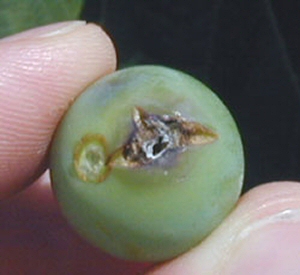Grape Berry Moth
 Scientific Name
Scientific Name
Endopiza viteana
Host
Grape berry moths feed on grapes, both cultivated and wild species. They prefer tender skinned varieties with tight fruit clusters.
Symptoms
Damage is caused by the larvae feeding in flowers and fruit. Small fruit, when damaged, turn dark purple in color and drop from the stems. Larger fruits are usually webbed into the cluster and shrivel or rot in place.
Life Cycle
This insect overwinters in the pupal stage in its cocoon. The larva forms its cocoon
by 
Description
The adult is a small moth with a wingspread of about 3/8 inch. The front wings are brown with a slight purplish sheen. The head is brown, and the center portion of the forewings may appear to have a dark saddle-like band running across them. Young larvae can be either yellowish green or dull white with a black head capsule. Mature larvae range from olive green to brown in color and are about 3/8 inch long. Caterpillars, when disturbed, wiggle and squirm vigorously to escape and will drop to the ground if possible.
Control
Please contact your local county extension office for current information.

